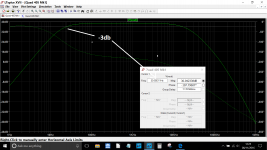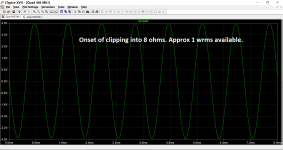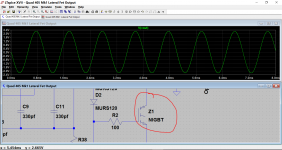Have a look at this thread. Post 12 shows graphically how the two currents from dumpers and class A stage come together in a working amplifier (not a Quad):
http://www.diyaudio.com/forums/soli...-learn-about-current-dumping.html#post4827251
http://www.diyaudio.com/forums/soli...-learn-about-current-dumping.html#post4827251
Regarding the virtual groud in Quad 306: I recall that changing the transformer to a double secondary winding type, removing the parts that create virtual GND and thus create a real GND was THE mod to do in its time... Reason for virtual GND was simply cost cutting. A clever solution for a non optimal choice. I forgot what replacement transformer was used but I think it was an ILP then, now called Amplimo. Quad 306 sounds better with a real GND, with its original virtual ground you have to deal with nonlinear impedance of the filter caps. Nice amp but no masterpiece because of this design choice 
There were also solutions to support the PCB better.
There were also solutions to support the PCB better.
Last edited:
I'm sure your correct on that Jean. Another possible reason to add (again to save cost) is that I suspect it allowed them to do away with a speaker relay and delay. I imagine the switch on thumps would be pretty horrific given a true DC coupled design and allowing for servo settling time.
At the end of the day everyone is after your money, and those that are, are always trying to save costs to make sure they get more of it
Its still a neat design though.
At the end of the day everyone is after your money, and those that are, are always trying to save costs to make sure they get more of it
Its still a neat design though.
Thanks for the info all.
Looking at the idea of paralell bridging a 306 I would say it is more complex than the 405 and would not encourage trying. However there is an upgrade you might try if your speakers are bi-wired. Have two 306 and feed each a mono signal. I suspect most preamps will drive both inputs as mono. Then use one output as bass and one as the rest ( that is a left amp and a right amp, not one stereo amp for bass and one for treble ). If the four speakers terminals ( bass, treble ) are truely separate ( measure with a meter black to black and red to red with links removed on speaker, it should read > 20 Mohms if that is the meter maximum ). One could try bass verses treble phasing to see if you agree with the speaker designers choice. The advantage of this idea is to reduce PSU current use and also have no PSU crosstalk. I think Quad always used a rule that the transformer was just able to to meet 8 ohms specification, saying that real music would never need more. One 306 per side looks to correct my only real doubt.
I think I am right that the 306 has an inverting output? If so the speaker phase might be important if using a non Quad ( non inverting ) preamp. Transients should be the debate as other sounds have no need for absolute phase. The old chestnut of the recording engineer may have got it wrong should be ignored. We want to hear what they heard is the correct thing. In some rooms it can be important. These are the ones with their own problems I suspect.
To be frank a spare 306 is the biggest upgrade you can do. The parts used inside the 306 are fine for 99% of us. If the capacitors are at the end of their life certainly better types can be used.
Did anyone ever try true audio FET's in a 405 ( For example Exicon 10N/P20 )? I have a hunch it could work. They can work with zero bias quite well ( circa 3 mA drain to source if gates together ). The 405 uses some negative feedback so could look to correct their less good linearity. It could be a good trade off. Normal IRF/IRFP FET's need too high a gate voltage to be a drop in replacements. Audio T03 FET's are source to case and bipolar collector to case etcetera. I could even imagine the 405 would drive them better than typical amps.
I think I read Crest PA amps have used this virtual ground PSU.
Looking at the idea of paralell bridging a 306 I would say it is more complex than the 405 and would not encourage trying. However there is an upgrade you might try if your speakers are bi-wired. Have two 306 and feed each a mono signal. I suspect most preamps will drive both inputs as mono. Then use one output as bass and one as the rest ( that is a left amp and a right amp, not one stereo amp for bass and one for treble ). If the four speakers terminals ( bass, treble ) are truely separate ( measure with a meter black to black and red to red with links removed on speaker, it should read > 20 Mohms if that is the meter maximum ). One could try bass verses treble phasing to see if you agree with the speaker designers choice. The advantage of this idea is to reduce PSU current use and also have no PSU crosstalk. I think Quad always used a rule that the transformer was just able to to meet 8 ohms specification, saying that real music would never need more. One 306 per side looks to correct my only real doubt.
I think I am right that the 306 has an inverting output? If so the speaker phase might be important if using a non Quad ( non inverting ) preamp. Transients should be the debate as other sounds have no need for absolute phase. The old chestnut of the recording engineer may have got it wrong should be ignored. We want to hear what they heard is the correct thing. In some rooms it can be important. These are the ones with their own problems I suspect.
To be frank a spare 306 is the biggest upgrade you can do. The parts used inside the 306 are fine for 99% of us. If the capacitors are at the end of their life certainly better types can be used.
Did anyone ever try true audio FET's in a 405 ( For example Exicon 10N/P20 )? I have a hunch it could work. They can work with zero bias quite well ( circa 3 mA drain to source if gates together ). The 405 uses some negative feedback so could look to correct their less good linearity. It could be a good trade off. Normal IRF/IRFP FET's need too high a gate voltage to be a drop in replacements. Audio T03 FET's are source to case and bipolar collector to case etcetera. I could even imagine the 405 would drive them better than typical amps.
I think I read Crest PA amps have used this virtual ground PSU.
Lateral FET's in a 405 is something I have wondered over. Actually replacing just the Class A driver could be the one to go for sonically.
Attachments
-
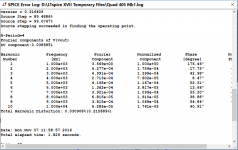 405.PNG37 KB · Views: 570
405.PNG37 KB · Views: 570 -
Quad 405 Mk1 Lateral Fet Driver.asc9.8 KB · Views: 60
-
Quad 405 Mk1 Lateral Fet Output and Driver.asc10 KB · Views: 55
-
Quad 405 Mk1 Lateral Fet Output.asc9.8 KB · Views: 64
-
Quad 405 Mk1.asc9.6 KB · Views: 61
-
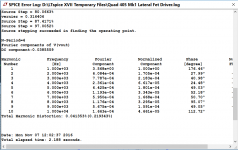 405 Lateral FET Driver.PNG38 KB · Views: 571
405 Lateral FET Driver.PNG38 KB · Views: 571 -
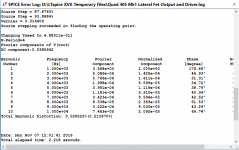 405 Lateral FET Output And Driver.PNG37 KB · Views: 575
405 Lateral FET Output And Driver.PNG37 KB · Views: 575 -
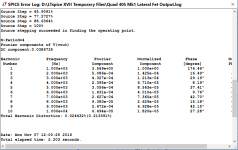 405 Lateral FET Output.PNG38 KB · Views: 576
405 Lateral FET Output.PNG38 KB · Views: 576
Sorry question setter for this diversion. FET's in 405's. I think that could be my next thing to play with. Thanks Mooly. Must do some work now, will read later.
This is the speaker that worked so well with 306. Not with a 300B as here. I helped David take them there. I don't agree with the review. I wish I had bought a pair. David is senior engineer at SSL who make mixing desks. He made a speaker so as to put off people trying to sell speakers to SSL. They seem to call in like double glazing salesmen. David let the would be supplier compare their speakers to his and call David in if they felt they were doing it better. If anyone did a similar speaker at DIY audio I would be very interested. David said " as we like audio to do square waves I figured speakers should also". David went on to say it's less fatiguing if they do. I totally agree. Also all the musical layers are heard. Mostly not intended ones I suspect. This speaker seems bright ( open ) and yet it isn't a strain to use for hours on end.
Orchid Audio PLL1 [English]
This is the speaker that worked so well with 306. Not with a 300B as here. I helped David take them there. I don't agree with the review. I wish I had bought a pair. David is senior engineer at SSL who make mixing desks. He made a speaker so as to put off people trying to sell speakers to SSL. They seem to call in like double glazing salesmen. David let the would be supplier compare their speakers to his and call David in if they felt they were doing it better. If anyone did a similar speaker at DIY audio I would be very interested. David said " as we like audio to do square waves I figured speakers should also". David went on to say it's less fatiguing if they do. I totally agree. Also all the musical layers are heard. Mostly not intended ones I suspect. This speaker seems bright ( open ) and yet it isn't a strain to use for hours on end.
Orchid Audio PLL1 [English]
Here is something I feel important. 405,306,606 are a familly. More than any other company Quad would have made sure the familly mostly differed only in power output. However to my ears all sounded different. Technically this is all understood and can be made different. It is not imagination to say it can be heard. The 405-2 was better than 405. It was Quad making sure professionals found the designs durable that caused this. A bit like limp home mode on cars better than blow up.
405. Dry or bass light, slightly bleached, sounded like a small 100 watts.
306. Warm,detailed and polite.
606. Large sound stage, neutral,excellent.
The strange part of the Orchid speaker story was on paper it was a match made in hell. Not true in real life. The Orchid at 89 dB/watt and a resistive 4 ohm load was ideal. There was no hint of current limiting and it went loud. Also the two were sonically well matched. The bit I didn't say is the preamp was an Audio Research. If you like the Quad was a buffer with voltage gain. On balance the better sound I ever heard and the Quad was not the poor relation. The Orchid amplifier was a work of art ( Hybrid FET and bipolar I think, mimicing a remote cut off power valve it was said ). It was marginally better, but slightly less easy on the ear.
I think what I heard in the 405/306/606 was how reactive speakers are as a load. The Quad designs show it more than others. I suggest the following. Although listening loud is not what we think we do, it is what we judge. The 306 and Orchid speakers was a giant killer combo. David the designer of the Orchid was surprised, but suggested it was in marketing terms something best forgotten. That wouldn't be him saying that, it would be the predudice of the world at large. I sit a bit on the fence on this. The Quad 405 types sometimes work and sometimes don't. Having said that I doubt the speakers are blameless. Sadly most Quad set up's I heard were choosen by reading hi fi mags. Seldom did they sound as good as a Rotel baby amplifier and some Heybrooks. That was because the typical Quad customer often would not get involved in asking if their choice was the best. For example the 405 and Spendor BC1 wasn't a total sucess ( lets be honest it is OK ). The Naim NAP 160 + BC1's was. Th designer of the BC1 felt the same ( he told me ). The NAP 160 was the design Quad rejected if my spies are right ( I wrote to the real designer, he wouldn't accept the praise, Alan M W ). It was a rather good amplifer tainted by super-hype. Quad 405 and KEF 107 was sublime. Alas not a likely combo. 405 and KEF 104's worked and by chance would be hi fi mag approved.
The 405 class A side. I wonder if the op amp used in the 405 could be pulled into SE class A using a current source ? There might be enough spare current to still do it's prime job. OK the book figures might look worse due to more second harmonic ( 0.05 % ? ). At least it would be all class A up to the 5 watts limit. If DC off set was a tad higher I could live with that. 405 is the mother design. The 303 is not of the same type. it is a masterpiece ( spectrum ).
I recently did the class A op amp trick on the LM324N op amp. It is a chip so bad that it nearly didn't make it to production ( it has crossover distortion ). It's designer said it was made cheap to hide their shame ( that's me adding a bit of colour ). I built the LM324 into a State Variable filter. I was very surprised how well it worked if hiss wasn't the prime question. I took it to very high frequecies also. It sat with a NE5532 mostly. Now that is not important except to say it works. My friend made a current dumper in the 1970's for his BSc. He used a 741 with that trick. I would guess 5 mA would sit in the right place. It might be less. BTW. If you are as perverted as me and want to improve a LM324 make all your stages inverting. It won't make a scrap of difference stage to stage, it will keep 2nd harmonic down.This is more true if using single voltage rail and typical biasing. LM324 is my favourite comparator as it can both sink and source current. It costs about the same as half a cigarette UK prices in small quantities. 4 devices in the chip and bomb proof. Sometimes something needs to be bad so as to get real data. Trust me LM324 is bad.
BTW. The 405 can be balanced to have vanishingly low HF distortion ( inductor in the bridge mainly) . Perhaps 20 dB better than claimed. Quad saw no reason to do that. Shame really as some of us would have paid 30% more for a 606 calibration with a nice badge. Dr Smith of Harwell ( UK's brains dept, JET, Diamond light source, Turbo Jet-Rockets nearby ) showed me his work on this. He said he thought he could hear a difference. What I learnt from him is the speed of the output transistors makes no difference to the 405. Devices that can not do 1 MHz are OK and will not change the results. The lower frequencies are dominated by negative feedback as in any conventional amp except they are dealing with a horrible gain notch at a rather low voltage. Hence me asking if FET's like BUZ900/905 wouldn't be better.
My mind says if the 405 current limiting was removed and FET's added the Krell amplifier would not be on my shopping list. Only one way to find out. I will also find the largest toroid transformer to fill the box, the 405 transformer is 200 VA I think I was told. It cooks if asked to give book spec for 10 minutes. The crest factor of real music is never worse than 3:1 ( 6:1 more typical ) which say 200 VA is enough. These days 500 VA is cheap. I suspect the amplifier would be just as durable. Vigortronics are OK for off the shelf.
You may ask why didn't Orchid make the big time? David is a genius and they don't do well. He is not easy to understand I would say. Most people do not like people who know more than them. I remember how we met. I was working on a valve transistor hybrid ( Quad-Rogers valve design with MPSA 42 LTP ). He looked over my shoulder and said " You are in great danger of that working ".
405. Dry or bass light, slightly bleached, sounded like a small 100 watts.
306. Warm,detailed and polite.
606. Large sound stage, neutral,excellent.
The strange part of the Orchid speaker story was on paper it was a match made in hell. Not true in real life. The Orchid at 89 dB/watt and a resistive 4 ohm load was ideal. There was no hint of current limiting and it went loud. Also the two were sonically well matched. The bit I didn't say is the preamp was an Audio Research. If you like the Quad was a buffer with voltage gain. On balance the better sound I ever heard and the Quad was not the poor relation. The Orchid amplifier was a work of art ( Hybrid FET and bipolar I think, mimicing a remote cut off power valve it was said ). It was marginally better, but slightly less easy on the ear.
I think what I heard in the 405/306/606 was how reactive speakers are as a load. The Quad designs show it more than others. I suggest the following. Although listening loud is not what we think we do, it is what we judge. The 306 and Orchid speakers was a giant killer combo. David the designer of the Orchid was surprised, but suggested it was in marketing terms something best forgotten. That wouldn't be him saying that, it would be the predudice of the world at large. I sit a bit on the fence on this. The Quad 405 types sometimes work and sometimes don't. Having said that I doubt the speakers are blameless. Sadly most Quad set up's I heard were choosen by reading hi fi mags. Seldom did they sound as good as a Rotel baby amplifier and some Heybrooks. That was because the typical Quad customer often would not get involved in asking if their choice was the best. For example the 405 and Spendor BC1 wasn't a total sucess ( lets be honest it is OK ). The Naim NAP 160 + BC1's was. Th designer of the BC1 felt the same ( he told me ). The NAP 160 was the design Quad rejected if my spies are right ( I wrote to the real designer, he wouldn't accept the praise, Alan M W ). It was a rather good amplifer tainted by super-hype. Quad 405 and KEF 107 was sublime. Alas not a likely combo. 405 and KEF 104's worked and by chance would be hi fi mag approved.
The 405 class A side. I wonder if the op amp used in the 405 could be pulled into SE class A using a current source ? There might be enough spare current to still do it's prime job. OK the book figures might look worse due to more second harmonic ( 0.05 % ? ). At least it would be all class A up to the 5 watts limit. If DC off set was a tad higher I could live with that. 405 is the mother design. The 303 is not of the same type. it is a masterpiece ( spectrum ).
I recently did the class A op amp trick on the LM324N op amp. It is a chip so bad that it nearly didn't make it to production ( it has crossover distortion ). It's designer said it was made cheap to hide their shame ( that's me adding a bit of colour ). I built the LM324 into a State Variable filter. I was very surprised how well it worked if hiss wasn't the prime question. I took it to very high frequecies also. It sat with a NE5532 mostly. Now that is not important except to say it works. My friend made a current dumper in the 1970's for his BSc. He used a 741 with that trick. I would guess 5 mA would sit in the right place. It might be less. BTW. If you are as perverted as me and want to improve a LM324 make all your stages inverting. It won't make a scrap of difference stage to stage, it will keep 2nd harmonic down.This is more true if using single voltage rail and typical biasing. LM324 is my favourite comparator as it can both sink and source current. It costs about the same as half a cigarette UK prices in small quantities. 4 devices in the chip and bomb proof. Sometimes something needs to be bad so as to get real data. Trust me LM324 is bad.
BTW. The 405 can be balanced to have vanishingly low HF distortion ( inductor in the bridge mainly) . Perhaps 20 dB better than claimed. Quad saw no reason to do that. Shame really as some of us would have paid 30% more for a 606 calibration with a nice badge. Dr Smith of Harwell ( UK's brains dept, JET, Diamond light source, Turbo Jet-Rockets nearby ) showed me his work on this. He said he thought he could hear a difference. What I learnt from him is the speed of the output transistors makes no difference to the 405. Devices that can not do 1 MHz are OK and will not change the results. The lower frequencies are dominated by negative feedback as in any conventional amp except they are dealing with a horrible gain notch at a rather low voltage. Hence me asking if FET's like BUZ900/905 wouldn't be better.
My mind says if the 405 current limiting was removed and FET's added the Krell amplifier would not be on my shopping list. Only one way to find out. I will also find the largest toroid transformer to fill the box, the 405 transformer is 200 VA I think I was told. It cooks if asked to give book spec for 10 minutes. The crest factor of real music is never worse than 3:1 ( 6:1 more typical ) which say 200 VA is enough. These days 500 VA is cheap. I suspect the amplifier would be just as durable. Vigortronics are OK for off the shelf.
You may ask why didn't Orchid make the big time? David is a genius and they don't do well. He is not easy to understand I would say. Most people do not like people who know more than them. I remember how we met. I was working on a valve transistor hybrid ( Quad-Rogers valve design with MPSA 42 LTP ). He looked over my shoulder and said " You are in great danger of that working ".
http://www.keith-snook.info/wireles...d-1975/Current Dumping Audio Amplifer DCD.pdf
Has anyone measured how much of the class A stage gets to the speakers notch free?
Has anyone measured how much of the class A stage gets to the speakers notch free?
The response of the original 405 does suggest it to be bass light by modern standards, although the -3db point is near 20Hz.
Removing the dumpers shows that around 1 wrms into 8 ohms is available. That limit occurs on the positive half cycle and appears to be driver/device related. The negative limit is set by the two series 560 ohm collector load for the class A output.
Removing the dumpers shows that around 1 wrms into 8 ohms is available. That limit occurs on the positive half cycle and appears to be driver/device related. The negative limit is set by the two series 560 ohm collector load for the class A output.
Attachments
So... on that basis then, using HEXFET's rather than laterals allows more output from the class stage before the dumpers turn on.
In simulation we can get almost 1.3 vrms across 8 ohms before the dumpers conduct. The laterals only around 120mv rms.
I might have more of play with these tomorrow. It would be interesting to compare distortion profiles.
In simulation we can get almost 1.3 vrms across 8 ohms before the dumpers conduct. The laterals only around 120mv rms.
I might have more of play with these tomorrow. It would be interesting to compare distortion profiles.
The IGBT might work if it has an internal feedforward resistor. I doubt it would. In a Darlington I believe these mostly are fitted to speed the device up by offering a discharge path, the FET will be discharged by the driver stage with ease so needs none. I also wondered if the addition of a diode would help the existing design.
Why the Audio FET might work is the curve never really switches off. I suspect negative feedback could be increased if like other MOS FET amps. Personally I wouldn't bother as first watt is my goal. I would extend the - 3 dB poing to maybe 7Hz and filter my preamp if needed. The 405 is filtered to protect the Quad speakers ( I was told ). It is said that's why Quad 33 adverts show the preamp at +1 on the bass which brings it to a possible user preference. That isn't right really as the curves don't overlap.
On the FET. David Mate of SSL said feedback works best with devices that don't have dramatic gain changes mV to mV. Absolute linearity is a job for feedback. If saying gm doubling is a probelm this FET dumper idea seems to kill many birds with one stone. I always thought the gm doubling was a false concept. If the error is placed at about 1 watt I doubt it matters. With Audio FET's the biasing is one fixed resistor. I see no harm if a feedforward corrected class AB. You might even get your wife/girlfriend or whatever to set it up by ear. They love music and I suspect keep away from gm debate. Self's Class A/C is nice. I would make the A bit 5 watts rather than 20. I tried Audio FET's as the class A 5 watts and found the biasing a doddle. The sound was not as good as AB as I don't think the devices suit this use. The measurements were supurb. If ear biasing Audio FET's there is a compromise between valve like openess and punch. 20 to 100 mA drain source seems where to try. Could be in the 405 zero bias would be fine.
Why the Audio FET might work is the curve never really switches off. I suspect negative feedback could be increased if like other MOS FET amps. Personally I wouldn't bother as first watt is my goal. I would extend the - 3 dB poing to maybe 7Hz and filter my preamp if needed. The 405 is filtered to protect the Quad speakers ( I was told ). It is said that's why Quad 33 adverts show the preamp at +1 on the bass which brings it to a possible user preference. That isn't right really as the curves don't overlap.
On the FET. David Mate of SSL said feedback works best with devices that don't have dramatic gain changes mV to mV. Absolute linearity is a job for feedback. If saying gm doubling is a probelm this FET dumper idea seems to kill many birds with one stone. I always thought the gm doubling was a false concept. If the error is placed at about 1 watt I doubt it matters. With Audio FET's the biasing is one fixed resistor. I see no harm if a feedforward corrected class AB. You might even get your wife/girlfriend or whatever to set it up by ear. They love music and I suspect keep away from gm debate. Self's Class A/C is nice. I would make the A bit 5 watts rather than 20. I tried Audio FET's as the class A 5 watts and found the biasing a doddle. The sound was not as good as AB as I don't think the devices suit this use. The measurements were supurb. If ear biasing Audio FET's there is a compromise between valve like openess and punch. 20 to 100 mA drain source seems where to try. Could be in the 405 zero bias would be fine.
- Status
- This old topic is closed. If you want to reopen this topic, contact a moderator using the "Report Post" button.
- Home
- Amplifiers
- Solid State
- Quad 306, an underrated masterpiece?
